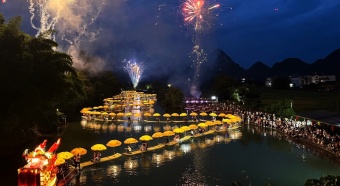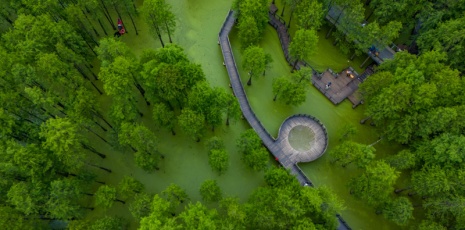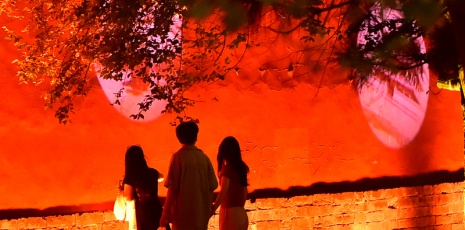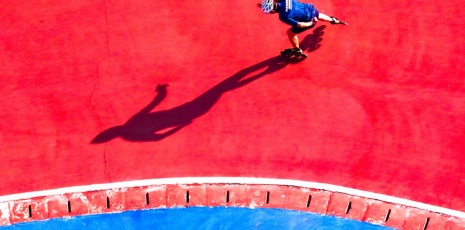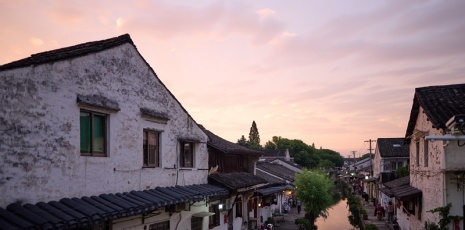
Solar Impulse 2 pilot Bertrand Piccard(L) and pilot Andre Borschberg celebrate after Borschberg landed at Kalaeloa Airport, Hawaii, the United States, July 3, 2015. Solar Impulse 2 (SI2), the first solar-powered aircraft in an attempt to fly around the world, safely landed at Kalaeloa Airport in Honolulu, Hawaii, at 5:51 a.m. local time (1551 GMT), Friday after 118-hour non-stop flight over Pacific. (Xinhua/Zhang Chaoqun)
by Zhang Chaoqun, Xue Ying
HONOLULU, July 3 (Xinhua) -- With a wing span of 72 meters, the Solar Impulse 2 (SI2) flew over the sky above the Kalaeloa Airport in Honolulu early Friday morning like a huge bird.
Hovering for about 4 hours above the airport, it finally landed in the first ray of sunlight before the eyes and cameras of over 100 reporters as well as more staff members and guests.
When the cockpit door opened, several traditional Hawaiian flower leis were immediately put around the neck of Andre Borschberg, the 62-year-old brave pilot and CEO of the project, to show the warm welcome by local people.
But it took about an hour for him to stand up and walk down the plane.
"It's a very ambitious step, five days and five nights at the limit of what weather forecast can do today. I am extraordinarily happy. There are a lot of reasons, but I think the most important one is it was something that I was dreaming about since I was a kid," said Borschberg, who got a 10-minute leg massage after staying in the small cockpit for 118 hours.
"One question that impressed me for the last days is that this airplane was flying without any problem, and I believe this kind of technology is extremely reliable," he said.
The journey from the central Japanese city of Nagoya broke three world records -- the longest solo flight by time and the longest solar-powered flight by time and distance.
SI2, the first solar-powered aircraft that attempts to fly around the world, arrived in Honolulu at 2:00 a.m. local time (1200 GMT) after finishing an 8,200-kilometer trip.
But due to the poor light condition at the airport at night, it had to hover in the sky for four more hours waiting to land at dawn and landed safely at 5:51 a.m. local time (1551 GMT).
Hawaii is the eighth leg of the plane's 35,000-kilometer journey around the world starting from Abu Dhabi on March 9. The idea of flying around the world with solar energy was first conceived by Bertrand Piccard after he made the first-ever non-stop round-the-world balloon flight in 1999.
"Renewable energies are presented as obstacles to development. We want to show the opposite, we want to show the renewable energy, the clean energy can achieve impossible goals," Piccard told Xinhua.
"That is a fantastic solution to grow, to create jobs, to make profits and also to protect the environment. And if you can fly around the world with an airplane that uses no fuel, just the power of sun, of course, this opens tremendous perspectives ... for ground transportation, for constructions of houses and everything," Piccard added.
The aircraft, piloted alternatively by Borschberg and Piccard, both of whom are Swiss explorers, demands over 500 flight hours or nearly three weeks in the air, spread over five months and broken up into 13 legs at speeds between 36 and 90 km per hour during the whole journey around the world. On the way to Hawaii, its average speed was around 70 kph.
The 3.8-cubic-meter cockpit Borschberg stayed in was unheated and unpressurized. When he crossed the ocean, Borschberg was only able to nap for 20 minutes at a time, the maximum amount of time the solar plane can navigate automatically.
In such a flight of long distance and time, Borschberg regarded the plane as his partner.
"This airplane brought me from Japan, this airplane allowed me to fly five days and five nights without any difficulty. When you left, you found you had created a relationship with it. I mean it's a partner, we together found ways over this voyage. And the tiny cockpit was my home, and I felt home there, I felt great," said Borschberg.
"The first 24 hours were very technical," said Borschberg, "but the second day was really getting me into the mission. It took me a while to create a relationship of trust with the airplane, which allowed me to rest and eventually sleep by periods of 20 minutes with the autopilot. The experience of flight was so intense that I could only focus on the present moment and discover how to deal with my own energy and mindset."
By doing yoga and meditation, Borschberg limbered up his muscles and joints in this long-distance flight to help him remain physically and mentally alert. He looked good when he walked out of the cockpit.
"Can you imagine that a solar-powered airplane without fuel can now fly longer than a jet plane," Piccard said earlier. "This is a clear message that clean technologies can achieve impossible goals."
Jose Andersen, a 38-year-old local resident, said he started to track the latest news of the solo flight since Monday when it left Japan for Honolulu.
"The success of SI2 will give people more confidence, (and) let them know that renewable energy, such as solar energy, is reliable," said Andersen, who decided to buy a new energy car to reduce his family's dependence on fossil fuel.
The plane weighs about as much as a family sedan and has 17,248 solar cells across its wingspan.
SI2 initially left Nanjing, China, on May 31 for Hawaii, but was forced to land in Nagoya due to "a wall of clouds" over the Pacific.
The next leg of the flight will take Borschberg and Piccard to Phoenix, Arizona before they fly together across the Atlantic on a return path to Abu Dhabi.
It took 12 years to build this solar plane and the first version in 2009 broke records for heights and distances travelled by a manned solar plane.
Swiss Ambassador to the United States Martin Dahinden welcomed the Solar Impulse team at the airport alongside Governor of Hawaii David Ige, who announced July 3, 2015 as the "Solar Impulse 2 Day" to remember this historical landing day.


